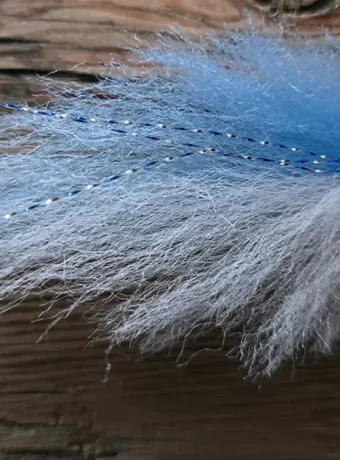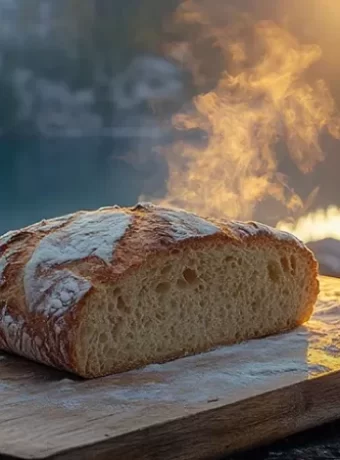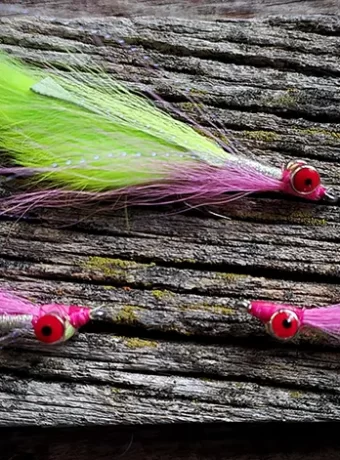Table of Contents
Early Salmon Flies (Atlantic Salmon)
The history of salmon flies begins in Europe, particularly in Scotland and Ireland, where anglers in the 18th and 19th centuries developed elaborate wet flies to entice Atlantic salmon. These flies—like the Jock Scott, Durham Ranger, and Green Highlander—featured exotic feathers (e.g., peacock, golden pheasant, macaw), silks, and tinsels. Detailed in books like George Kelson’s The Salmon Fly (1895) and T.E. Pryce-Tannatt’s How to Dress Salmon Flies (1914), they were more art than utility, reflecting Victorian aesthetics and the wealth of anglers. These flies were fished wet, swung through rivers, and relied on bright colors and movement to provoke strikes.
Transition to the American West
In North America, fly fishing evolved differently. By the late 19th and early 20th centuries, anglers in the western U.S. began targeting trout and steelhead (anadromous rainbow trout, often called “summer-run salmon” in some regions). The giant salmonfly hatch—a key food source on rivers like the Deschutes, Madison, and Yellowstone—spawned a new class of flies. These patterns mimicked the adult salmonfly’s large, robust silhouette and orange-black coloration, shifting focus from wet flies to buoyant dries designed to float high and provoke aggressive surface strikes.
The Sofa Pillow: A Milestone
The Sofa Pillow, developed in the 1940s or 1950s (exact origins are murky), is attributed to Pat Barnes, a guide on Montana’s Madison River and Yellowstone River. It emerged as a rugged, high-floating dry fly to imitate the salmonfly during its chaotic late-spring hatch. With a bulky elk-hair wing, red floss body, and grizzly hackle, it was simple, durable, and effective for steelhead and trout. The Sofa Pillow marked a departure from delicate Eastern dries, embracing the West’s big water and big fish ethos.
Evolution to the Stimulator
The Stimulator, created by Randall Kaufmann in the 1980s, refined the Sofa Pillow concept. Kaufmann, a fly shop owner and Deschutes River angler, blended the Sofa Pillow’s salmonfly imitation with influences from Madam X (a rubber-legged attractor) and traditional hair-wing dries like the Royal Wulff. The Stimulator kept the elk-hair wing and hackle but added a dubbed body, flashier colors (yellow, orange, olive), and a palmered hackle for extra buoyancy and buggy appeal. It became a versatile “searching” fly, imitating not just salmonflies but stoneflies, caddis, and hoppers. Its adaptability made it a modern classic.
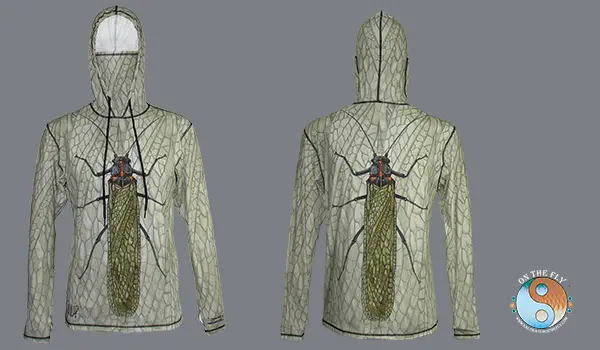
Salmon Fly Graphic Hoodie
Protection from the sun is as important as selecting the correct fly pattern. Our Outdoor Apparel is a UPF 50 with a sewn face mask in the Graphic Hoodies.
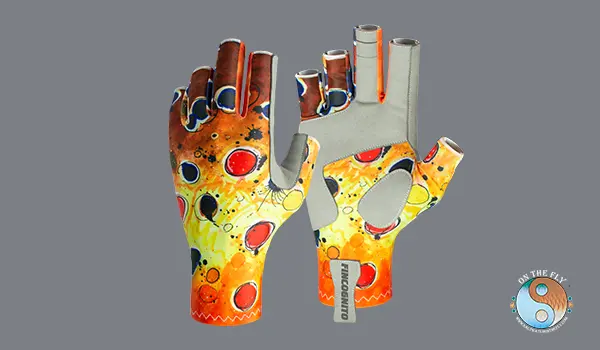
Graphic Sun Gloves for Salmon Fly Fly Fishing
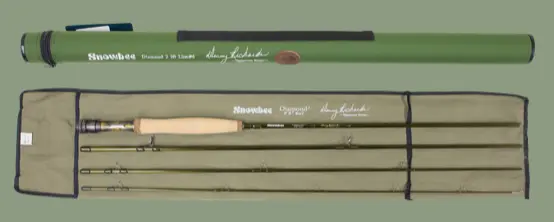
Nine Foot, Six Weight Fly Rod for Salmonfly Fly Fishing
Text content
How to Tie: From Sofa Pillow to Stimulator
Sofa Pillow Designed by Pat Barnes
Description: A big, no-nonsense salmonfly imitation with a bold profile and high float. Materials:
-
- Hook: 3XL dry fly hook (Partridge Streamer Hook), size 4-8
-
- Thread: 3/0 waxed Semperfli, black, red, olive, orange, its an endless list almost.
-
- Body: Red floss, dubbing, Crystallized Flash or any other material you fancy
-
- Rib: Fine gold wire (optional, some omit it)
-
- Wing: Elk hair, natural or bleached
-
- Hackle: Grizzly, two feathers, oversized
-
- Tail: None (traditional versions skip it)
Tying Steps:
-
- Start the Thread: Secure the hook in the vise. Start the thread at the eye and wrap a base layer back to the bend.
- Tie in the Floss: Attach red floss at the bend. Wrap forward to the two-thirds point of the shank, forming a thick, even body. Tie off and trim.
- Rib (Optional): Tie in gold wire at the bend, wrap it in 4-6 open spirals over the floss, and tie off.
- Wing: Cut a generous clump of elk hair, clean the underfur, and stack if desired. Measure it to extend just past the bend. Tie it in at the two-thirds point, tips rearward, with tight wraps. Trim the butts at an angle.
- Hackle: Tie in two grizzly hackles (convex sides together) at the wing base, tips pointing forward. Wrap both hackles forward in 6-8 turns, palmer-style, to the eye. Tie off and trim.
- Finish: Build a small thread head, whip finish, and apply head cement.
Notes: Keep the wing dense for flotation; sparse hackle can sink it. Fish it dead-drift or twitched during a hatch.
Stimulator a Randall Kaufman Design
Description: A refined, multi-purpose dry fly with a slimmer profile and more flash. Materials:
-
- Hook: 2XL or 3XL dry fly hook (e.g., TMC 200R or Daiichi 1270), size 4-12
-
- Thread: 6/0 or 3/0 UNI-Thread, black or orange
-
- Tail: Elk hair or deer hair, flared
-
- Body: Orange, yellow, or olive dubbing (e.g., Antron or Superfine)
-
- Rib: Fine gold or copper wire
-
- Wing: Elk hair, natural or dyed
-
- Hackle: Grizzly or brown, palmered + a collar hackle
-
- Thorax: Peacock herl or dubbed dubbing (matching body color)
Tying Steps:
-
- Start the Thread: Secure the hook in the vise. Lay a thread base from eye to bend.
- Tail: Cut a small clump of elk hair, clean it, and tie it in at the bend, flaring it slightly (about shank length). Trim butts.
- Rib: Tie in gold wire at the bend.
- Body: Apply dubbing to the thread and wrap a tapered body from bend to two-thirds point. Wrap the wire rib forward in 5-6 turns, tie off.
- Wing: Stack a clump of elk hair, measure it to reach the tail tips, and tie it in at the two-thirds point. Trim butts at an angle.
- Hackle: Tie in a grizzly hackle at the wing base. Palmer it rearward over the body in 5-7 turns, catch it with the rib wire, and tie off at the bend.
- Thorax: Dub a small amount of peacock herl or matching dubbing from the wing base to just behind the eye.
- Collar Hackle: Tie in a second hackle (grizzly or brown), wrap 2-3 turns forward, tie off at the eye.
- Finish: Build a neat head, whip finish, and cement.
Notes: Vary colors—orange for salmonflies, yellow for golden stones, olive for caddis. The palmered hackle and flared tail give it a lively, buggy look.
Evolution Recap
-
- Sofa Pillow: Simple, bulky, salmonfly-specific. Red floss and elk hair dominated early western patterns.
-
- Stimulator: Added tail, dubbed body, ribbing, and thorax for versatility. Shifted from single-species imitation to an all-purpose attractor.
Both flies reflect the practical ingenuity of western tiers, adapting to fast rivers and aggressive fish. Want detailed steps for a specific color variation or more historical context? Let me know!
Given your interest in the Sofa Pillow and Stimulator—both iconic dry flies tied to imitate salmonflies (the giant stonefly, Pteronarcys californica)—I’ll focus on additional salmon fly variations in the same vein: large, buoyant dry flies designed for trout and steelhead, particularly tied to mimic the salmonfly hatch or related stoneflies. These patterns build on the Sofa Pillow’s rugged simplicity and the Stimulator’s versatility, offering options for different conditions, species, and creative twists. Below are some notable variations, their histories, and how to tie them.
1. Clark’s Stonefly
History: Developed by Allan Clark in the 1970s on Idaho’s Henry’s Fork, this pattern mimics adult salmonflies and golden stoneflies. It’s a bulkier, more impressionistic take than the Sofa Pillow, emphasizing flotation for rough water. Target: Trout, steelhead on western rivers. Materials:
-
- Hook: 3XL dry fly hook (e.g., TMC 200R), size 4-10
-
- Thread: 3/0 monocord, black
-
- Tail: Deer hair, flared
-
- Body: Orange or black dubbing (e.g., mohair or Antron)
-
- Wing: Elk hair, natural
-
- Hackle: Brown or grizzly, two feathers
-
- Rib: Fine gold wire (optional)
Tying Steps:
-
- Lay a thread base from eye to bend.
-
- Tie in a small clump of deer hair at the bend, flaring it for a short, bushy tail (half shank length).
-
- Tie in gold wire at the bend (optional). Dub a thick, tapered body to the two-thirds point.
-
- Rib the body with 4-5 turns of wire, tie off.
-
- Stack a hefty clump of elk hair, tie it in at the two-thirds point, tips extending to the tail. Trim butts.
-
- Tie in two oversized hackles at the wing base, palmer forward to the eye in 6-8 turns, tie off.
-
- Whip finish and cement. Notes: Use orange for salmonflies, black for nocturnal stones. Fish it with a twitch in riffles.
2. Chubby Chernobyl
History: A modern evolution from Idaho tiers in the 2000s (popularized by Rainy’s Flies), the Chubby Chernobyl blends salmonfly and hopper traits. Its foam body and rubber legs make it unsinkable—an upgrade from the Sofa Pillow for fast, turbulent water. Target: Trout, steelhead, grayling. Materials:
-
- Hook: 2XL or 3XL dry fly hook (e.g., Daiichi 1280), size 4-12
-
- Thread: 6/0 UNI-Thread, tan or black
-
- Underbody: 2mm tan or orange foam
-
- Overbody: 2mm black foam (or orange for salmonfly)
-
- Wing: Elk hair or poly yarn, white or tan
-
- Legs: Rubber legs, black or orange (two pairs)
-
- Indicator: Poly yarn, bright yellow or pink (optional)
Tying Steps:
-
- Cut a strip of tan foam (hook shank length), tie it in at the bend, extending halfway off the rear.
-
- Tie in a second strip of black foam at the bend, aligning with the tan foam.
-
- Wrap thread to the two-thirds point. Fold both foam strips forward, tie down, leaving a stubby tail.
-
- Tie in rubber legs on each side at the two-thirds point.
-
- Tie in a wing of elk hair or poly yarn over the foam, tips to the tail.
-
- Advance thread to just behind the eye. Fold foam forward again, tie down, and trim excess.
-
- Add a second pair of legs and a poly yarn indicator (optional).
-
- Whip finish and cement. Notes: Orange/black mimics salmonflies; tan/yellow works for golden stones or hoppers. Deadly as a dry-dropper rig.
3. Norm Wood Special
History: Created by Norm Wood in the 1960s for Oregon’s Deschutes River, this salmonfly pattern emphasizes a low profile and realistic silhouette, contrasting with the Sofa Pillow’s bulk. It’s a favorite among steelhead anglers. Target: Steelhead, trout. Materials:
-
- Hook: 3XL dry fly hook (e.g., Mustad 94831), size 4-8
-
- Thread: 3/0 monocord, orange or black
-
- Tail: Moose mane or elk hair, sparse
-
- Body: Orange floss or dubbing
-
- Wing: Elk hair, natural, tied flat
-
- Hackle: Grizzly, sparse
Tying Steps:
-
- Lay a thread base from eye to bend.
-
- Tie in a sparse clump of moose mane or elk hair at the bend for a short tail.
-
- Wrap an orange floss body (or dubbed body) to the two-thirds point, keeping it slim.
-
- Tie in a flat elk-hair wing at the two-thirds point, tips to the tail, extending slightly past the bend.
-
- Tie in a grizzly hackle, wrap 3-4 turns forward, tie off at the eye.
-
- Whip finish and cement. Notes: Rides lower than the Sofa Pillow—ideal for picky fish in clear water.
4. Kaufmann’s Salmonfly
History: Another Randall Kaufmann creation from the 1980s, this pattern refines the Sofa Pillow with a dubbed body and segmented look, aiming for a closer salmonfly match. It’s less versatile than the Stimulator but hyper-effective during hatches. Target: Trout during salmonfly hatches. Materials:
-
- Hook: 3XL dry fly hook (e.g., TMC 200R), size 4-8
-
- Thread: 6/0 UNI-Thread, black
-
- Tail: Elk hair or moose mane
-
- Body: Orange dubbing (e.g., SLF or mohair)
-
- Underwing: Black deer hair
-
- Overwing: Elk hair, natural
-
- Hackle: Grizzly, palmered
-
- Thorax: Black dubbing
Tying Steps:
-
- Lay a thread base.
-
- Tie in a sparse elk-hair tail at the bend.
-
- Dub an orange body to the halfway point.
-
- Tie in a small clump of black deer hair as an underwing, tips to the tail.
-
- Tie in a larger elk-hair overwing over the deer hair.
-
- Tie in a grizzly hackle at the wing base, palmer forward to the two-thirds point, tie off.
-
- Dub a black thorax to the eye.
-
- Whip finish and cement. Notes: The two-tone body and layered wings mimic the salmonfly’s natural coloration.
5. Rogue Foam Salmonfly
History: A foam-based pattern from Oregon’s Rogue River in the 1990s, this fly swaps hair for foam to boost flotation and durability—a practical twist on the Sofa Pillow for heavy water. Target: Steelhead, trout. Materials:
-
- Hook: 2XL dry fly hook (e.g., Daiichi 1270), size 4-10
-
- Thread: 3/0 monocord, black
-
- Body: 2mm orange foam
-
- Underwing: Black foam or deer hair
-
- Overwing: Tan or gray 2mm foam
-
- Hackle: Grizzly or black, sparse
-
- Legs: Rubber legs, black (optional)
Tying Steps:
-
- Cut an orange foam strip, tie it in at the bend, extending as a short tail.
-
- Wrap thread to the two-thirds point, fold foam forward, tie down.
-
- Tie in a black foam or deer-hair underwing, tips rearward.
-
- Cut a tan foam strip, tie it in over the underwing as an overwing, trim excess.
-
- Tie in rubber legs (optional) on each side.
-
- Tie in a grizzly hackle, wrap 2-3 turns, tie off at the eye.
-
- Whip finish and cement. Notes: Foam keeps it riding high; tweak colors (black/orange, tan/gray) for local hatches.
Additional Variations and Customization
-
- Golden Stone Versions: Swap orange for yellow or tan (e.g., Stimulator in yellow, Chubby in tan/black) to match golden stoneflies (Hesperoperla pacifica).
-
- Size Adjustments: Scale down to size 10-14 for smaller stoneflies or up to 2-4 for big steelhead flies.
-
- Materials: Experiment with synthetics like EP Fibers or Flashabou for flash, or biots for segmented bodies.
-
- Attractor Twists: Add hot pink or chartreuse accents for visibility in murky water.
Tying Tips Across Variations
-
- Flotation: Elk/deer hair or foam is key—don’t skimp, especially in fast currents.
-
- Profile: Match the salmonfly’s chunky, 1.5-2-inch body and broad wings.
-
- Durability: Use strong thread (3/0 or heavier) and cement liberally for toothy fish like steelhead.
These patterns trace a lineage from the Sofa Pillow’s raw functionality to modern hybrids like the Chubby Chernobyl, blending tradition with innovation.

